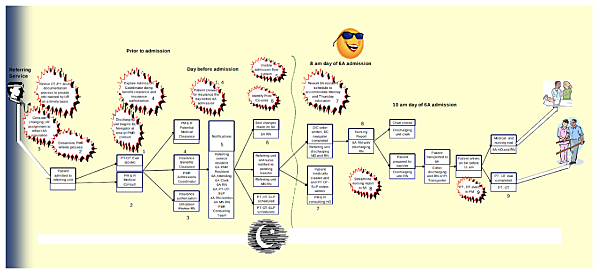You may be the best when it comes to marketing. You may be getting the attention of mass media with your guerrilla marketing efforts or leading a successful small-scale Google AdWords campaign.
But your efforts won’t matter much unless you can handle the leads you’re generating. Combine amazing marketing with a poor sales process, and you get a disaster.
When it comes to improving your business’ workflow, there are few better options than value stream management or VSM. What does this term mean and how can it help you solve problems that may be costing you thousands of dollars per year? Read on, and you’ll learn the answers from academic research and executive managers of Toyota.
What is a value stream mapping?
If you’ve been searching business literature for the best approach to conduct business, Toyota's might be it. In fact, the Japanese car manufacturer’s approach was so popular among western businesses it even got a book of its own—named "The Toyota Way."
If you're not familiar with the book, or Toyota’s contribution to business thinking, you've likely heard about lean thinking or lean methodology. James Womack and Daniel Jones popularized the term in the book "Lean Thinking," which was published in 1990.
But Toyota is a car manufacturer, how does all of this relate to ecommerce? The techniques described in these books were developed for the automotive industry. The broader concepts, however, are applicable anywhere.
The heart and soul of Toyota’s way is Kaizen, the strife to bring customers their products or services as fast as possible while keeping quality high. Do you think it’s all talk and little action? Here’s what one of the practices of this methodology looks like in real life.

Source: Trello
Yes, the entire idea behind Trello and similar apps is Kanban, which the Toyota executives came up with. Put simply, it’s a visualization of workflow that helps you keep track of tasks passing from one stage to another.
Now that you know a bit about lean thinking, we finally get to value stream mapping. It’s a significant part of the Toyota way that helped executives solve the biggest problem they had: how to manage workflow to consistently provide excellent service fast.
Their solution was VSM, which is a way to visualize your workflow, referred to as value stream, and find holes and bottlenecks in it. Different industries will handle this differently, and there are many ways to denote value streams, but the core idea of VSM bottles down to one thing, and that is: Inspect every step the product goes through from when the order is placed until the customer gets it, look for problems in the workflow, and improve them.
Should I use VSM for my business?
Toyota’s way helped create a tool most ecommerce business owners use—Trello. If that's not enough to compel you to give value stream mapping a try, check out this list of reasons:
- VSM shows how your business really operates in a visual, intuitive way
- VSM helps find redundancies and bottlenecks in workflows
- VSM helps you give clients better products faster for the same price
Ready to learn more about value stream mapping? Here’s a quick guide that will help you do a VSM for your ecommerce business:
How do I create a value stream map for my business?
VSM is something Toyota executives do, right? It was invented by them, but any ecommerce business owner can do it as well.
Gather a team
Start by gathering a team of people who’ll be drawing the map. The team should include key stakeholders, people who are great at analytics, and who know how departments work. If you have a limited team but a decent budget, consider hiring a consultant for value stream mapping.
Locate a problematic process
Doing VSM on all processes in your business is a good idea, but you’re better off starting with one process. Find the process in your business that creates the most waste in terms of time or complaints from customers, and prepare to dissect it.
Study the workflow
Once you know what you’re going to study, define when the process starts and ends. That may not be as straightforward as you think. Kate Brooks from Pro Essay Writer provides a great example: the process of the customer getting answers from support starts from them making the first contact.
If you analyze it starting from the time the support rep answers, you may be missing a huge problem. Define the fence posts, and follow this checklist to figure out what’s wrong with the process.
- What is the most common complaint from the customers?
- What are the main stages the product/service goes through before it gets to the customer?
- How much time does it take between the client making a request and receiving the order?
- How much time does each stage take?
- How much time passes between the stages?
- How does the quality change in each stage?
Once you get all of that information on the value stream, you may already start seeing problems. Interview employees to get their take on what’s wrong with the process.
Don’t be too fast to take on their advice on how to solve the problems, though. Your employees may have to deal with them firsthand, but it’s you who has the strategic vision of the company.
Draw the map
Now that you have all of the information you need, it’s time to get to the drawing board. This is how a typical value stream map would look according to people who wrote a book on VSM.

Source: L Martin, K. & Osterling, M. (2014). Value Stream Mapping
You may also do a VSM-lite like researchers from the University of Michigan did.

If you’re taking a lighter approach to drawing, make sure you’re taking time into consideration. This map may not show it, but the researchers had extensive Excel documents that studied the time it took to perform each stage.
Find the waste
When you have a map drawn on the whiteboard or in the software you use, it’s time to make actionable changes. Look for places in the value stream where value is wasted. This waste manifests itself when at a certain stage your employees are wasting their time or creating a subpar product.
The exact reason is up to you to determine. It may be because your employees didn’t have enough training or don’t have the software that performs best. The solutions may differ from changing workflow to changing the software you utilize. Either way, it’s a problem you need to address.
How do you do that? Let’s look at the common problems and solutions to find out.
Keep track of every important detail with Keap Pro. Get a tool that houses all your client activity and communications in one place. Try us for free for 14 days at the link 👉 https://t.co/b9iufh98rl pic.twitter.com/7mrELyMSsS
— Keap (@KeapGrowing) April 5, 2020
Common problems VSM can discover and how to solve them
Value stream mapping is widely used outside the manufacturing industry. Here are some examples from a University of Michigan study on the health industry as well as cases that are common in the ecommerce industry.
Lack of standards for communication
The University of Michigan study took a closer look at a local hospital through the lens of VSM. One of its key findings is that the hospital had no official standard of communication. As a result, the staff would submit notes on patients in batches, and some people had to wait an extra day to get to the next stage of treatment.
You can find the same problem in your ecommerce business. If you communicate with your employees in morning meetings or via email, updates on projects may take a day to get to the Kanban board.
Set up a task management system that all employees would update at certain times to solve this problem.
Poor workflow management
The hospital case study found that some patients were waiting to get processed because the insurance company took too much time to confirm payment. The solution the University of Michigan came up with was placing contacting the insurance company higher up the list in the workflow.
This is a common problem all businesses have to deal with. If you find that progress on the project is stalling because, say, your programmers have the UI elements but not the UX design, you need to place UX design up the list of priority tasks.
Apply this to any business, and you’ll improve waiting times.
Lack of accountability
This problem is common in SMEs, but even large hospitals face it. The staffers know what needs to get done, but they don’t know who needs to do it and when. The task gets passed around and ends up delayed.
You can solve this problem the same way the University of Michigan experts did it. Set up a time-management system that assigns tasks to employees and tracks time goals.
Lack of time to process
Big companies need VSM because they have plenty of resources but don’t use them wisely. A problem ecommerce business owners face is that they don’t have enough resources.
When you do VSM for your business, you may find a problem that can’t be solved by improving the systems you already have. For instance, what if your support gets complaints because support reps can’t handle all of the requests they get per day?
To solve this kind of problem, you need to think like a Toyota executive. Change the way that system works by introducing automation. It's the best way to solve time-related problems that a small team of an ecommerce business has.
Keep improving
If there’s one thing the Toyota way teaches it’s to never stop improving. Take its advice and learn more about VSM and business analytics in general.
To learn more about VSM, check out "Value Stream Mapping" by Karen Martin and Mike Osterling, and "Lean Thinking: Banish Waste and Create Wealth in Your Corporation" by James Womack and Daniel Jones.
If you want to get an even closer look at how your business operates, learn about SIPOC analysis, Fishbone diagram, and Gemba analysis. Learn about customer journey mapping to get a detailed look into your marketing process.


